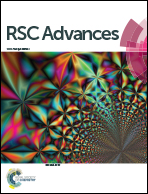Growth of branched gold nanoparticles on solid surfaces and their use as surface-enhanced Raman scattering substrates†
Abstract
Branched gold (Au) nanoparticles (NPs) were synthesized directly on surfaces of three different supports (silicon, glass, indium tin oxide (ITO)) by following a “seed-mediated” method. Growth of the nanostructures in high yield and all with branched morphology was achieved on all surfaces. Nanostructures with desired characteristics were synthesized by determining the optimum seed size (8 nm Au nanospheres) and pH (3.00) of the growth solution. The Au NPs synthesized under these conditions have branched morphologies with average sizes of ca. 450 nm and are well dispersed on the support surface. Surface-enhanced Raman scattering (SERS) spectroscopy studies were performed using Rhodamine 6G (R6G) as a probe molecule. The results revealed strong SERS activity of the synthesized Au NPs for the detection of R6G in concentrations as low as 1 nM with an enhancement factor (EF) estimated as greater than 8 orders of magnitude.


 Please wait while we load your content...
Please wait while we load your content...